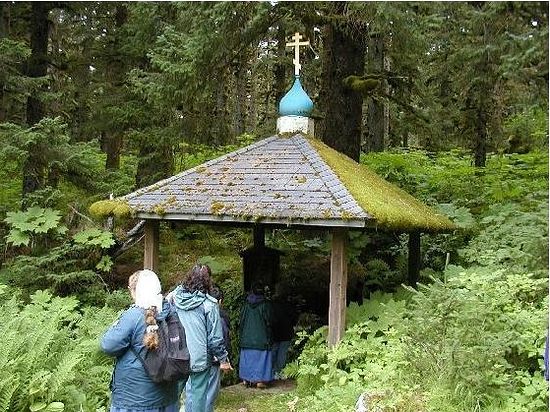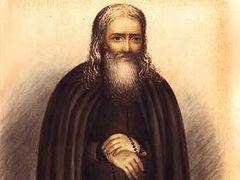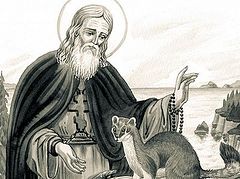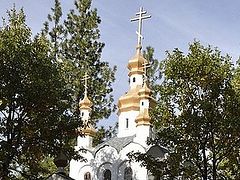“Enveloped in mist, the shore only becomes clear as the boat glides into the protected bay. On all sides, cliffs emerge from the tattered veil of fog. Towering spruces precariously balance on jagged rock shelves, threatening to dash themselves into the sea. The spray of crashing waves pelts the solitary black-robed figure attempting to pull his boat onshore. The fierce winds still for a moment and the low clouds part to allow through a ray of sun, illuming the forest beyond the beach. There, more spruce gently sway above a moss-laden slope, releasing steam like incense as it warms. Turning back from whence he came, the quiet figure gazes onto the gray storm-tossed sea; the ever-changing Eternal looms in front of him. Soaring above the waves, the chime of bells in the distance shatters the solemn dirge of the ocean. Quickly securing the boat, he begins walking toward the warm glow of the candle-lit chapel, and to prayer…”1
St. Herman lived such a life on Spruce Island in Alaska, described above, and felt at home there because its beautiful, although sometimes dangerous nature reminded him so much of his faraway home in Valaam Monastery in far western Russia.
 Spruce Island / pravoslavie.ru
Spruce Island / pravoslavie.ru
Beauty drew his sensitive soul, for he knew that beauty in creation is a reflection of the beauty of the Creator. Beauty, and the sense of calm that one finds in reading the above passage are sorely missing in America today, whether among the religious or atheists.
The bare concrete walls of Protestant churches no longer have even a hint of beauty. Catholic churches in America are increasingly going along the same path. How often do we hear people lamenting that so much money was “wasted” in the past in making such “gaudy” churches? And then there are the LGBTQ (and now there is a push for P for pedophile) pride marches, now degraded even further into mere hate processions against the president, that show men trading in their inherent dignity as human beings for perverse and tragic displays of beastlike passions.
There is no understanding of the importance of beauty and its effect on the soul because there is no more concept of or grasp of Truth or spiritual sensitivity. Man has no idea what is happening in his own heart and soul.
But St. Herman was a man of sensitivity. The pious Orthodox Christian senses the depths of his own sins and thus his great need of repentance in order to find God. Valaam was his place of repentance; Valaam has been the place of repentance of thousands of monks for over a millennium. And repentance means, in the Orthodox Tradition, not merely asking for forgiveness or having a feeling of contrition when we have done something wrong, but it is an entire lifestyle of constantly turning from everything within us that falls short of the glory of God, and it continues for an entire lifetime.
But St. Herman was sent from his beloved home to traverse roughly 6,000 miles westward across the vast Russian expanse as part of a spiritual mission to bring the light of the Orthodox faith of the native Alaskan peoples.
 Modern day piligrims arriving to Spruce Island by boat / oca.org
Modern day piligrims arriving to Spruce Island by boat / oca.org
The light of Christ shone brightly in Valaam Monastery, and it shone brightly in St. Herman. That is why he was able to uproot himself from his little slice of earthly paradise on Valaam Island and travel to a strange land: The more that Christ reigns within, the less our personal whims and desire can reign. The life of a monk is one of humble obedience.
The obedience of a humble monastic, of which St. Herman is an example par excellence, is another of the missing pieces in America today. Humility and obedience may get our lip service, but in reality, such “spinelessness” is mocked and derided. A real man must be “strong.”
True humility means even accepting false accusations against ourselves silently, and even with gratitude to our slanderer for offering us the chance to be humbled. Such profundity is anathema in America.
St. Herman and his missionary team set out in 1793 and arrived in Alaska in 1794. By the early 1800s, St. Herman was the only monk left of the initial ten, and he took up a hermit’s life on the eastern end of Spruce Island, which itself lies eleven miles northwest of Kodiak, across the channel.
This humble and wild island became holy in St. Herman’s time, and it remains holy to this day. Everything in the Orthodox faith is wholly centered on the Person of Christ, Who is both God and man. That is, Christ took on a physical, created nature. Accordingly, the Orthodox value creation and see its potential for bearing the grace of God. Icons are holy, church buildings are holy, the physical elements of the Sacraments are holy, bodies can be holy—and when the soul departs at death, the grace that was present in the saint and his surrounding environment does not suddenly depart.
Salvation is a cosmic affair in holy Orthodoxy. Adam and Eve were called to sanctify all of creation, though the Fall left that job up to Christ and His saints. And Spruce Island is a “picture perfect” example of this teaching. The island is home to St. Herman’s original resting place, it is home to St. Herman’s miraculous healing spring, it is home to a holy monastery, and much more.
St. Herman lived a strict life of asceticism—of prayer “without ceasing” (Thess. 5:17), of all-night vigils, of fasting, of selfless care of all who came to home, of self-emptying for the sake of being filled with Christ. And St. Herman became filled with Christ, and thus Spruce Island became holy.
Creation itself obeys the holy and is sanctified in their presence, as was true of Adam and Eve before their sin. This is why so many varied animals could live at peace together on Noah’s Ark—his righteousness made them all as lambs.
The same was true with St. Herman. The animals sensed Paradise within him and were tamed. He was friends with birds and bears and all manner of animals on the island. And what’s more, nature and the weather itself obeyed the ascetic, as is the case with one of his most “famous” miracles. When tremors forewarned the island natives of a coming tsunami, they instinctively ran to their holy father in the faith for help. St. Herman placed an icon of Mary, the Mother of God, on the shore and began to pray to God. He then told the natives to be calm, for the sea would not pass the spot where the holy icon had been placed. And so it happened. This place is known as “Icon Bay” to this day.
Environmentalists, some of whom essentially fall just short of worshiping creation, could have their entire lives changed by St. Herman of Alaska. Creation is healed and elevated by the holiness of man, and not his ideology-driven rallies and marches.
Such miracles as that described above have continued after St. Herman’s 1837 death. In 1842, he turned to calm a turbulent wind that had been preventing St. Innocent of Alaska’s boat from landing, by his prayerful intercessions. In 1907, a young girl, crippled from the age of two, began to walk after falling onto St. Herman’s grave and tearfully pouring her heart out to him. Likewise, a spring where St. Herman would draw water has become a fount of healings after his death.
 St. Herman's miraculous healing spring / pravoslavie.org
St. Herman's miraculous healing spring / pravoslavie.org
Miracles also flow from his original burial place in the nearby Church of Sts. Sergius and Herman of Valaam (and from his relics, which are now in Holy Resurrection Cathedral in Kodiak). Graves and relics—the remains of a saint—do not signify a morbid obsession with death, but quite the opposite. Relics show the believer, with eyes to see and ears to hear, the overflowing life that comes only from Jesus Christ. They are a slice of the Paradise we are meant to abide in.
They, along with the whole of Spruce Island, and with the whole of St. Herman’s life, are a slice of that beauty that America so sorely needs. Pilgrims flock to Spruce Island annually to venerate the holy places of St. Herman’s life, and to taste a taste of that peace and serenity and humility and beauty that pervaded his life.
And behind, or beyond, the physical beauty of the island lies the incomparably deeper beauty of Paradise, which reigned in St. Herman’s heart, and which therefore overflowed into the creation around him.
St. Herman can be an aid to the reawakening of spiritually dull America. If we want it, the beauty of all things St. Herman can help us begin to know what is happening in our own hearts and souls.





